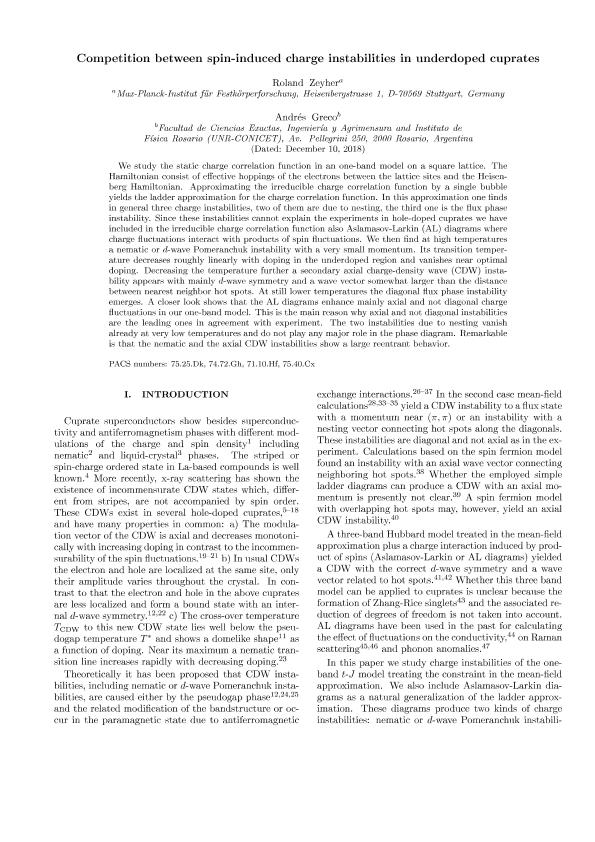Mostrar el registro sencillo del ítem
dc.contributor.author
Zeyher, Roland
dc.contributor.author
Greco, Andres Francisco

dc.date.available
2020-03-25T18:29:55Z
dc.date.issued
2018-12
dc.identifier.citation
Zeyher, Roland; Greco, Andres Francisco; Competition between spin-induced charge instabilities in underdoped cuprates; American Physical Society; Physical Review B; 98; 22; 12-2018; 1-12
dc.identifier.issn
0163-1829
dc.identifier.uri
http://hdl.handle.net/11336/100741
dc.description.abstract
We study the static charge correlation function in a one-band model on a square lattice. The Hamiltonian consists of effective hoppings of the electrons between the lattice sites and the Heisenberg Hamiltonian. Approximating the irreducible charge correlation function by a single bubble yields the ladder approximation for the charge correlation function. In this approximation, one finds, in general, three charge instabilities - two of them are due to nesting, the third one is the flux phase instability. Since these instabilities cannot explain the experiments in hole-doped cuprates, we have included in the irreducible charge correlation function also Aslamasov-Larkin (AL) diagrams where charge fluctuations interact with products of spin fluctuations. We then find at high temperatures a nematic or d-wave Pomeranchuk instability with a very small momentum. Its transition temperature decreases roughly linearly with doping in the underdoped region and vanishes near optimal doping. Decreasing the temperature further, a secondary axial charge-density wave (CDW) instability appears with mainly d-wave symmetry and a wave vector somewhat larger than the distance between nearest-neighbor hot spots. At still lower temperatures, the diagonal flux phase instability emerges. A closer look shows that the AL diagrams enhance mainly axial and not diagonal charge fluctuations in our one-band model. This is the main reason why axial and not diagonal instabilities are the leading ones in agreement with experiment. The two instabilities due to nesting vanish already at very low temperatures and do not play any major role in the phase diagram. Remarkable is that the nematic and the axial CDW instabilities show a large reentrant behavior.
dc.format
application/pdf
dc.language.iso
eng
dc.publisher
American Physical Society

dc.rights
info:eu-repo/semantics/openAccess
dc.rights.uri
https://creativecommons.org/licenses/by-nc-sa/2.5/ar/
dc.subject
cupratos
dc.subject
charge order
dc.subject.classification
Física de los Materiales Condensados

dc.subject.classification
Ciencias Físicas

dc.subject.classification
CIENCIAS NATURALES Y EXACTAS

dc.title
Competition between spin-induced charge instabilities in underdoped cuprates
dc.type
info:eu-repo/semantics/article
dc.type
info:ar-repo/semantics/artículo
dc.type
info:eu-repo/semantics/publishedVersion
dc.date.updated
2020-03-25T13:27:11Z
dc.journal.volume
98
dc.journal.number
22
dc.journal.pagination
1-12
dc.journal.pais
Estados Unidos

dc.description.fil
Fil: Zeyher, Roland. Max Planck Institute For Solid State Research; Alemania
dc.description.fil
Fil: Greco, Andres Francisco. Consejo Nacional de Investigaciones Científicas y Técnicas. Centro Científico Tecnológico Conicet - Rosario. Instituto de Física de Rosario. Universidad Nacional de Rosario. Instituto de Física de Rosario; Argentina
dc.journal.title
Physical Review B

dc.relation.alternativeid
info:eu-repo/semantics/altIdentifier/url/https://journals.aps.org/prb/abstract/10.1103/PhysRevB.98.224504
dc.relation.alternativeid
info:eu-repo/semantics/altIdentifier/doi/http://dx.doi.org/10.1103/PhysRevB.98.224504
Archivos asociados
